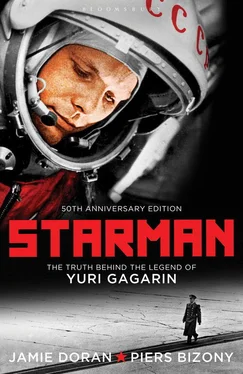The heat of re-entry created an ionization layer around the ball, and no voice radio messages could get through. Korolev and his ground controllers probably did not become fully aware of Gagarin’s problem until after he had landed.
Atmospheric heating eventually burned through the cable and separated the rogue equipment module, but the effect was to sling the ball away at a tangent with an additional sickening spin. At one point the rotation was so severe that Gagarin began to lose consciousness. ‘The indicators on the instrument panels became fuzzy, and everything seemed to go grey.’
Perhaps the State Committee’s discussions of this problem did not come soon enough for the engineers to make suitable adaptations, ahead of Gherman Titov’s mission? At any event, he survived a similar difficulty when he flew on August 6, 1961. Gagarin’s post-flight description of the separation failure was perfectly calm, quite relaxed, but Titov says that if his own experience was anything to go by, he must have wondered: ‘Which is stronger, the capsule or the other module? Which will break first? You switch on all the recorders and transmitters, to try and report in case you don’t make it. You see the little earth globe rotating, and the clocks still running, which means information is still coming from the equipment module through the cables. The capsule rotates very fast. Then there’s a huge shaking. Both compartments are hitting each other. Is it scary? That’s an interesting question. I could have been scorched, but so what? Similar things have happened.’
At last Gagarin heard denser air whistling past the ball and his whirlwind rotation became less severe. Outside the charred porthole he saw pale blue sky. He was shaken, but any minute now he knew that further stresses awaited him. At seven kilometres’ altitude the hatch above his head blew away. The noise was terrible. The cabin seemed suddenly so very open, so exposed. According to Gagarin’s published account, he wondered for a crazy moment: ‘Was that me? Did I eject just then?’
His account does not quite square with the recollection of Vladimir Yazdovsky, Korolev’s Director of Medical Preparations, and a member of the ground-control team at the time. He remembers Gagarin triggering the ejection himself.
The entire procedure was supposed to be automatic. When the pressure sensors registered an atmospheric pressure consistent with an altitude of seven kilometres, Gagarin would come shooting out of the ball, and at four kilometres, the ejection seat’s propulsion pack and large parachute canopy would fall away, releasing him so that he could descend more gently under his smaller personal parachute. If his seat did not fire at the right time of its own accord, then he had the option of triggering the ejection himself, but he was not supposed to do this without good reason. [8] The Vostok flight plan and ejection sequence are described in Newkirk, Dennis, Almanac of Soviet Manned Spaceflight , Houston: Gulf, 1990, pp. 7–21.
As the ball began to slow down in the denser atmosphere and the heat of the initial re-entry faded away, Gagarin’s radio link with ground control was restored. According to Yazdovsky, ‘He reported that the g-loads were still very heavy, and they were pulling him in different directions. We said, “Hang on in there.” We suggested to him not to eject too soon, but he ejected early, from an undefined height.’
It seems that the ground controllers were unaware of the separation problem that Gagarin had encountered earlier and did not realize why he was complaining about excess spin and g-loading. Perhaps Gagarin did not have time to explain in greater detail; or perhaps he knew that he should not discuss the separation problem over the voice link, in case any Western listening posts were eavesdropping. The dialogue in this very last phase of the mission has never been published, but the historian Philip Clarke believes that the ball might still have been rotating at an uncomfortable rate, long after the equipment module had finally separated. Gagarin’s decision to eject early was not necessarily a panic reaction. He may have believed that the spinning of his capsule would interfere with his ejection, and the sooner he attempted it, the better.
In the event, Gagarin’s ejection and touchdown went smoothly. As soon as the ejection seat’s rocket charges were spent, a large parachute canopy unfurled to slow down his fall. Then the seat fell away, as planned, leaving him to drift more gently to the ground under his own parachute.
Baikonur’s morning was Washington’s night. At 1.07 Eastern Standard Time, American radar stations recorded the launch of an R-7 rocket, and fifteen minutes later a radio monitoring post in the Aleutian Islands off Alaska detected unmistakable signs of live dialogue with a cosmonaut. White House science advisor Jerome Wiesner called President Kennedy’s press secretary Pierre Salinger with the news. Salinger had already prepared a statement for Kennedy to read out. The President had gone to bed a few hours earlier with a sense of foreboding. Wiesner asked him whether he wanted to be woken as soon as the rocket was launched? ‘No,’ the President answered wearily. ‘Give me the news in the morning.’ [9] Murray & Cox, Apollo: The Race to the Moon , p. 76.
At 5.30 a.m. Washington time, the Moscow News radio channel announced Gagarin’s successful landing and recovery. An alert journalist called NASA’s launch centre in Florida to ask if America could catch up. Press officer John ‘Shorty’ Powers was trying to catch a few hours’ rest in his cramped office cot. He and many other NASA staffers were working 16-hour days in the lead-up to astronaut Alan Shepard’s first flight in a Mercury capsule. When the phone at his side rang in the pre-dawn silence, he was irritable and unprepared. ‘Hey, what is this!’ he yelled into the phone. ‘We’re all asleep down here!’ Next morning the headlines read: ‘SOVIETS PUT MAN IN SPACE. SPOKESMAN SAYS US ASLEEP.’ [10] Shepard, Alan & Slayton, Deke, Moonshot , London: Virgin, 1995, pp. 105–6. See also: The Times , April 13, 1961, p. 12, ‘We Are Asleep’.
On the afternoon of April 12, President Kennedy held a press conference in Washington. Normally a self-confident and eloquent public performer, he seemed distinctly less sure of himself than usual. He was asked, ‘Mr President, a member of Congress today said he was tired of seeing the United States coming second to Russia in the space field. What is the prospect that we will catch up?’
‘However tired anybody may be – and no one is more tired than I am – it is going to take some time. The news will be worse before it gets better. We are, I hope, going to go into other areas where we can be first, and which will bring perhaps more long-range benefits to mankind. But we are behind.’ [11] Swenson, Grimwood & Alexander, This New Ocean , p. 335. See also: ‘Ups and downs in Space as US gets set to launch man’, Life magazine, May 5, 1961.
Korolev, Mazzhorin and the trajectory mappers at OKB-1 knew precisely the direction that Gagarin’s ball would adopt as it plunged through the atmosphere and fell to the ground. What they did not know was exactly how far along that direction it would travel before coming to rest. The trajectory calculations from Mtislav Keldysh’s computers were good to an accuracy of just a few kilometres. In the vastness of outer space this was more than acceptable. For a homecoming Vostok ball it could have meant the difference between landing harmlessly in an empty field and crashing through a roof, killing all the people beneath. With great care, Vostok’s incoming route was selected to place as few houses as possible in the path of danger. All the descent scenarios favoured large meadowlands, scrublands and fields.
Читать дальше












